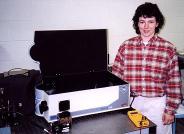
The Visible Spectrum of Hydrogen vs. Deuterium
Suzanne Fiacco '01
Abstract:
The purpose of this project is to use a reflection spectrometer to find the differences in wavelengths between the spectrum of hydrogen atoms and the spectrum of deuterium atoms. Hydrogen and deuterium share common characteristics. Deuterium is also known as heavy hydrogen because the weight of deuterium is twice that of hydrogen. Hydrogen is the simplest atom, which consists of one proton and one electron while deuterium is made up of one neutron, one proton, and one electron. Since the physical properties indicate that hydrogen and deuterium are very similar, one would expect their wavelengths to be very similar. In this projects, we calculated three of the visible wavelengths in the hydrogen spectrum to be 656.478 nm, 486.542 nm, and 434.415 nm. For deuterium we calculated that these wavelengths shift to 656.296 nm, 486.409 nm, and 434.295 nm respectively due to the additional mass in the neutron in the nucleus. In doing this experiment we measured the wavelengths in the hydrogen atom to be 656.489 nm, 486.44 nm, and 434.238 nm. For deuterium we measured the visible wavelengths to be 656.295 nm, 486.315 nm, and 434.115 nm. After measuring the intensity verses wavelength for the visible spectrum, we can determine the shift in wavelength for the red, blue, and violet lines as we change the source from hydrogen to deuterium. We conclude that the percent error between the differences in wavelengths between the spectrum of hydrogen and the spectrum of deuterium to be 1.65%, 5.3%, and 2.5% for the wavelengths of red, blue, and violet respectively.
For more information, contact Dr. Catherine Jahncke:
|
|
||
| © | St. Lawrence University | Department of Physics |
| Revised: 25 Jun 2003 | Canton, NY 13617 |